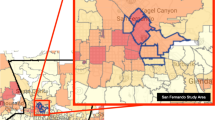Abstract
A quantitatively robust yet parsimonious air-quality monitoring network in mountainous regions requires special attention to relevant spatial and temporal scales of measurement and inference. The design of monitoring networks should focus on the objectives required by public agencies, namely: 1) determine if some threshold has been exceeded (e.g., for regulatory purposes), and 2) identify spatial patterns and temporal trends (e.g., to protect natural resources). A short-term, multi-scale assessment to quantify spatial variability in air quality is a valuable asset in designing a network, in conjunction with an evaluation of existing data and simulation-model output. A recent assessment in Washington state (USA) quantified spatial variability in tropospheric ozone distribution ranging from a single watershed to the western third of the state. Spatial and temporal coherence in ozone exposure modified by predictable elevational relationships (∼ 1.3 ppbv ozone per 100 m elevation gain) extends from urban areas to the crest of the Cascade Range. This suggests that a sparse network of permanent analyzers is sufficient at all spatial scales, with the option of periodic intensive measurements to validate network design. It is imperative that agencies cooperate in the design of monitoring networks in mountainous regions to optimize data collection and financial efficiencies.
Similar content being viewed by others
References
Böhm, M., McCune, B. and Vandetta, T.: 1991, ‘Diurnal curves of tropospheric ozone in the western United States’ Atmos. Environ. 25A, 1573–1590.
Brace, S. and Peterson, D.L.: 1998, ‘spatial patterns of tropospheric ozone in the Mount Rainier region of the Cascade Mountains’ U.S.A., Atmos. Environ. 32, 3629–3637.
Brauer, M. and Brook, J.R.: 1997, ‘Ozone personal exposures and health effects for selected groups residing in the Fraser Valley’ Atmos. Environ. 31, 2113–2121.
Bytnerowicz, A., Fenn, M.E., Miller, P.R. and Arbaugh, M.J.: 1999, ‘Wet and dry pollutant deposition to the mixed conifer forest’ in: Oxidant air pollution impacts in the montane forests of southern California, Miller, P.R. and McBride, J.R. (eds.), Springer-Verlag, New York, pp. 235–269.
Chameides, W.L., Saylor, R.D. and Cowling, E.B.: 1997, ‘Ozone pollution in the rural United States and the new NAAQS’ Science 276, 916.
Cooper, S.M. and Peterson, D.L.: 1999, ‘spatial distribution of tropospheric ozone in western Washington’ USA, Environ. Pollut.In press.
Fujioka, F.M., Roads, J.O. and Chin, S.-C.: 1999, ‘Climatology’ in: Oxidant air pollution impacts in the montane forests of southern California, Miller, P.R. and McBride, J.R. (eds.), Springer-Verlag, New York, pp. 28–43.
Good, P.: 1994, Permutation tests: a practical guide to resampling methods for testing hypotheses, Springer-Verlag, New York.
Innes, J.L.: 1998, ‘Measuring environmental change’ in: Ecological scale: theory and applications, Peterson, D.L. and Parker,V.T. (eds.), Columbia University Press, New York, pp. 429–457.
Koutrakis, P., Wolfson, J.M., Bunyaviroch, W., Froelich, S.E., Hirano, K. and Mulik, J.D.: 1993, ‘Measurement of ambient ozone using a nitrite-coated filter’ Anal. Chem.65, 209–214.
Miller, P.R.: 1992, ‘Mixed conifer forests of the San Bernardino Mountains, California’ in: The response of Western forests to air pollution, Olson R., Binkley D.K and Böhm, M. (eds.) Springer-Verlag, New York, pp. 461–497.
Peterson, D.L., Arbaugh, M.J. and Robinson, L.J.: 1991, ‘Growth trends of ozone-stressed ponderosa pine (Pinus ponderosa) in the Sierra Nevada of California, USA’ The Holocene 1, 50–61.
Peterson, D.L., Bowers, D. and Brace, S.: 1999, ‘Tropospheric ozone in the Nisqually River drainage, Mount Rainier National Park’ Northwest Sci.in press.
Steyn, D.G., Bottenheim, J.W. and Thomson, R.B.: 1997, ‘Overview of tropospheric ozone in the Lower Fraser Valley, and the Pacific ‘93 field study’ Atmos. Environ. 31, 2025–2037.
Van Ooy, D. and Carroll, J.J.: 1995, ‘The spatial variation of ozone climatology on the western slope of the Sierra Nevada’ Atmos. Environ. 29, 1319–1330.
Author information
Authors and Affiliations
Rights and permissions
About this article
Cite this article
Peterson, D.L. Monitoring Air Quality in Mountains: Designing an Effective Network. Environ Monit Assess 64, 81–91 (2000). https://doi.org/10.1023/A:1006498704222
Issue Date:
DOI: https://doi.org/10.1023/A:1006498704222




